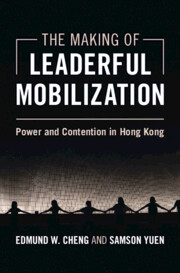Book contents
- Reviews
- The Making of Leaderful Mobilization
- Cambridge Studies in Contentious Politics
- The Making of Leaderful Mobilization
- Copyright page
- Dedication
- Contents
- Figures
- Tables
- Preface
- Acknowledgements
- Notes on Transliteration
- Abbreviations
- 1 Introduction
- Part I Context
- Part II Episodes
- Part III Mechanisms
- 6 Sectoral Networks
- 7 Loss of Innocence
- 8 Peer Collaboration
- 9 Money Matters
- 10 Radicalization with Solidarity
- 11 Conclusion
- Appendices
- References
- Index
8 - Peer Collaboration
from Part III - Mechanisms
Published online by Cambridge University Press: 30 January 2025
- Reviews
- The Making of Leaderful Mobilization
- Cambridge Studies in Contentious Politics
- The Making of Leaderful Mobilization
- Copyright page
- Dedication
- Contents
- Figures
- Tables
- Preface
- Acknowledgements
- Notes on Transliteration
- Abbreviations
- 1 Introduction
- Part I Context
- Part II Episodes
- Part III Mechanisms
- 6 Sectoral Networks
- 7 Loss of Innocence
- 8 Peer Collaboration
- 9 Money Matters
- 10 Radicalization with Solidarity
- 11 Conclusion
- Appendices
- References
- Index
Summary
Chapter 8 expounds on how the Anti-Extradition Movement was organized and sustained in the absence of a centralized leadership. We illustrate how protesters, networked in both online and offline realms, collaborated on a spontaneous, horizontal, and many-to-many basis to generate a continuous stream of actions – a process we term “peer collaboration.”
- Type
- Chapter
- Information
- The Making of Leaderful MobilizationPower and Contention in Hong Kong, pp. 173 - 191Publisher: Cambridge University PressPrint publication year: 2025

